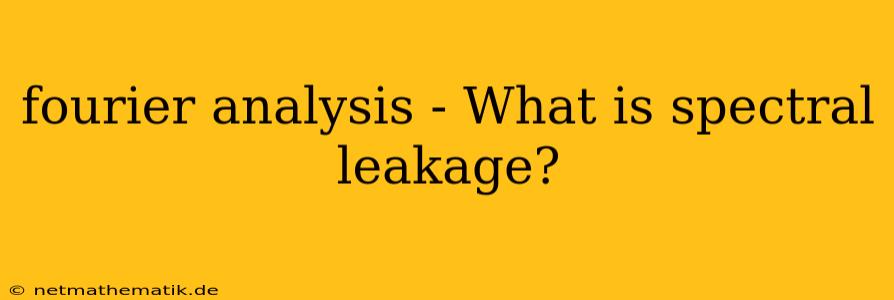Fourier analysis is a powerful tool used in various fields like signal processing, image processing, and physics. It allows us to decompose a signal into its constituent frequencies, providing insights into the underlying structure of the signal. However, a common problem that arises in practical applications of Fourier analysis is spectral leakage, which can distort the results and lead to misinterpretations. This article will delve into the phenomenon of spectral leakage, explaining its causes, effects, and methods for mitigation.
Understanding Spectral Leakage
Spectral leakage occurs when the signal being analyzed is not an integer multiple of the analysis window length. This leads to the energy from the signal's true frequencies spilling over into adjacent frequency bins during the Fourier transform.
To understand this better, let's visualize a simple example. Imagine a pure sinusoidal signal with a frequency of 10 Hz. When we perform a Fourier transform on this signal, ideally, we should observe a single peak at 10 Hz with no energy at other frequencies. However, if the signal's duration is not an integer multiple of the analysis window, the signal will be truncated, creating a discontinuity at the edges of the window. This discontinuity introduces high-frequency components into the signal, leading to spectral leakage, where some energy from the 10 Hz signal spreads to adjacent frequencies, creating a "smeared" peak in the frequency spectrum.
Causes of Spectral Leakage
The primary cause of spectral leakage is the finite length of the analysis window. In real-world applications, we only have a finite duration of the signal available for analysis. This finite duration introduces discontinuities at the window's edges, which, as we saw in the example above, generate spurious frequencies.
Other contributing factors to spectral leakage include:
- Non-stationary signals: Signals that change in time, such as a speech signal, can exhibit spectral leakage because the frequency content changes within the analysis window.
- Window function choice: The choice of the window function used to multiply the signal before performing the Fourier transform significantly influences the amount of spectral leakage. Some window functions, like the rectangular window, have sharp transitions at the edges, leading to more spectral leakage. Smoother window functions, like the Hanning or Hamming window, reduce spectral leakage by introducing less abrupt transitions at the edges.
- Sampling rate: If the sampling rate is not high enough, the signal may not be adequately captured, leading to aliasing and spectral leakage.
Effects of Spectral Leakage
Spectral leakage can lead to several undesirable effects, including:
- Misinterpretation of frequency components: The spread of energy due to spectral leakage can obscure true frequency components, making it difficult to identify the signal's dominant frequencies accurately.
- Distortion of the frequency spectrum: Spectral leakage can distort the overall shape of the frequency spectrum, making it difficult to analyze the signal's frequency content accurately.
- Difficulty in accurate signal reconstruction: Due to the distortion introduced by spectral leakage, reconstructing the original signal from its frequency components can be challenging.
Mitigation Techniques
Fortunately, several techniques can help minimize or mitigate spectral leakage:
- Windowing: As mentioned earlier, the choice of window function significantly impacts spectral leakage. Selecting a suitable window function can significantly reduce spectral leakage by smoothing the signal at the edges of the analysis window. Commonly used windows include Hanning, Hamming, Blackman-Harris, and Kaiser.
- Zero-padding: By adding zeros at the end of the signal before performing the Fourier transform, we can effectively increase the length of the analysis window. This reduces spectral leakage by increasing the frequency resolution of the spectrum and minimizing the effect of discontinuities at the window's edges.
- Longer signal duration: If possible, collecting a longer duration of the signal can also help reduce spectral leakage. This reduces the relative impact of the signal's edges on the analysis and leads to a more accurate frequency spectrum.
- Advanced techniques: Techniques like the Welch method, which divides the signal into overlapping segments and averages their spectra, can further mitigate spectral leakage by reducing the impact of individual windowed segments.
Conclusion
Spectral leakage is a common phenomenon in Fourier analysis that arises due to the finite length of the analysis window. It can distort the frequency spectrum and make it challenging to accurately interpret the signal's frequency content. Understanding the causes of spectral leakage and implementing mitigation techniques such as windowing, zero-padding, and using longer signal durations can significantly improve the accuracy of Fourier analysis results. By carefully considering these factors, we can minimize the impact of spectral leakage and obtain reliable insights from the frequency domain analysis of signals.
